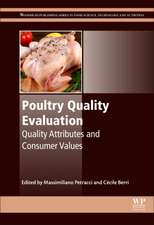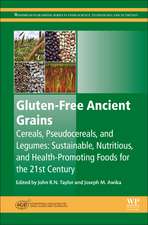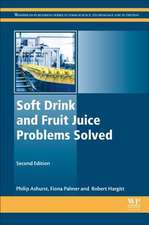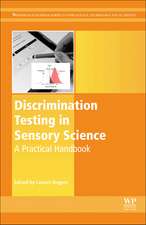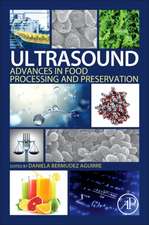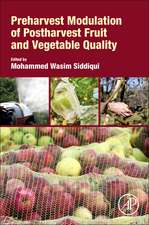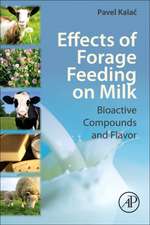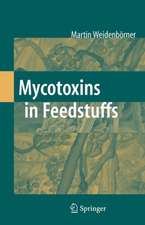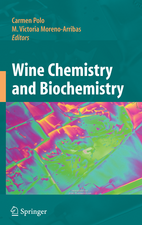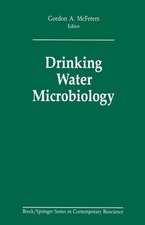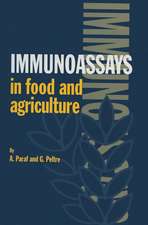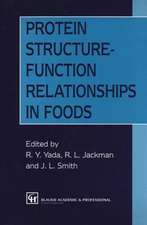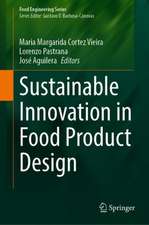Pectin: Technological and Physiological Properties
Editat de Vassilis Kontogiorgosen Limba Engleză Paperback – 2 oct 2021
This text presents the technological and physiological properties of pectin in an educational approach that encompasses all of the essential information a researcher needs to fully understand their function and use in foods. Utilizing basic information on pectin as well as recent technological advances, this book is designed to be the primary resource for individuals seeking out an up to date reference work covering all the necessary informational and functional aspects of pectin.
Pectin: technological and physiological properties is the first book to fully focus on the introductory concepts on pectin. Individual chapters cover localization and function, the structural aspects of pectin, pectinases, isolation and characterization and recovery from agricultural wastes. Important current advances such as emulsions, films, digestion, metabolism and bioactive properties are also focused on.
With its combination of vital basic information and technological advances, this book presents full and up to date coverage on this pectin and its many forms and uses in foods.
With its combination of vital basic information and technological advances, this book presents full and up to date coverage on this pectin and its many forms and uses in foods.
| Toate formatele și edițiile | Preț | Express |
|---|---|---|
| Paperback (1) | 777.50 lei 6-8 săpt. | |
| Springer International Publishing – 2 oct 2021 | 777.50 lei 6-8 săpt. | |
| Hardback (1) | 947.38 lei 6-8 săpt. | |
| Springer International Publishing – 2 oct 2020 | 947.38 lei 6-8 săpt. |
Preț: 777.50 lei
Preț vechi: 948.18 lei
-18% Nou
Puncte Express: 1166
Preț estimativ în valută:
148.79€ • 161.57$ • 124.99£
148.79€ • 161.57$ • 124.99£
Carte tipărită la comandă
Livrare economică 22 aprilie-06 mai
Preluare comenzi: 021 569.72.76
Specificații
ISBN-13: 9783030534233
ISBN-10: 3030534235
Ilustrații: XI, 207 p. 23 illus., 20 illus. in color.
Dimensiuni: 155 x 235 mm
Greutate: 0.31 kg
Ediția:1st ed. 2020
Editura: Springer International Publishing
Colecția Springer
Locul publicării:Cham, Switzerland
ISBN-10: 3030534235
Ilustrații: XI, 207 p. 23 illus., 20 illus. in color.
Dimensiuni: 155 x 235 mm
Greutate: 0.31 kg
Ediția:1st ed. 2020
Editura: Springer International Publishing
Colecția Springer
Locul publicării:Cham, Switzerland
Cuprins
Table of Contents
Chapter 1 Biosynthesis, Localisation, and Function of Pectins in Plants 8
1.1 Pectin biosynthesis. 8
1.2 Localisation of pectins in plants. 11
1.3 Pectin functions in plants. 13
Chapter 2 Pectin Structure. 25
2.1 Introduction.. 25
2.2 Galacturonans. 28
2.2.1 Homogalacturonans. 28
2.2.2 Galacturonans substituted with more or less complex side-chains. 31
2.3 Rhamnogalacturonan I 35
2.3.1 Rhamnogalacturonan I backbone. 35
2.3.2 Rhamnogalacturonan I side-chains. 37
2.3.3 Side-chain intra- and inter-molecular distribution.. 39
2.4 Connection between pectin domains. 40
2.5 Conclusions. 42
Chapter 3 Pectin Degrading Enzymes. 50
3.1 Introduction.. 50
3.2 Homogalacturonan-degrading enzymes. 51
3.2.1 Polygalacturonases (PG). 52
3.2.2 Pectin and pectate lyases. 55
3.2.3 Pectin methylesterases (PMEs). 57
3.2.4 Pectin acetylesterases (PAE). 59
3.3 Rhamnogalacturonan-degrading enzymes. 61
3.3.1 Rhamnogalacturonan-hydrolases. 61
3.3.2 Rhamnogalacturonan-lyases. 62
3.3.3 Rhamnogalacturonan-acetylesterase. 64
3.4 Side-chain degrading enzymes. 64
3.4.1 Arabinanases and α-arabinofuranosidases. 64 3.4.2 Galactanases and β-galactosidases. 66
3.4.3 Feruloylesterases. 68
3.5 Synergistic action of pectin degrading enzymes. 69
3.6 Conclusion.. 70
Chapter 4 Isolation and Characterisation of Pectin.. 80
4.1 Introduction.. 80
4.2 Extraction of pectin.. 82
4.2.1 Conventional extraction methods. 83
4.2.2 Enzymatic extraction.. 84
4.2.3 Microwave-assisted extraction.. 84
4.2.4 Ultrasonic extraction.. 85
4.2.5 Sub-critical water extraction/accelerated solvent extraction.. 85
4.3 Characterisation of pectin.. 86
4.3.1 Phenol-sulfuric acid/total carbohydrate assay. 86
4.3.2 Galacturonic acid content and degree of methyl esterification (DM). 87
4.3.3 Sugar composition.. 89
4.3.4 Molar mass and molar mass distribution.. 91
4.3.5 Intrinsic viscosity. 94
4.3.6 Rheology. 96
4.4. Conclusions. 98
Chapter 5 Emulsification Properties of Pectin.. 107
5.1. Introduction.. 107
5.2. Role of structural elements on the interfacial activity. 109
5.2.1 The role of protein.. 109
5.2.2 The role of acetyl and methyl groups. 111
5.2.3 The role of molecular weight and side chains. 112
5.3. Phenomenology of pectin adsorption at the oil-water interface. 115
5.4. Conclusions. 121
Chapter 6 Edible Films and Coatings with Pectin.. 125
6.1. Introduction.. 125
6.2. Edible films and coatings from pectins: elaboration and physical properties. 130
6.3. Pectin-based films and coatings in food preservation.. 139
6.4. Conclusions. 150
Chapter 7 Pectin Gelation and its Assembly into Functional Materials 159
7.1 Introduction.. 159
7.1.1 A soft matter exemplar. 159
7.1.2 Evolved pectin networks. 160
7.1.3 Current human exploitation.. 161
7.1.4 Unlocking the potential 161
7.2 Making pectin gels. 162
7.2.1 Different types of junction zones. 162
7.2.2 Different assembly procedures. 167
7.2.3 Practical top-tips for making gels. 171
7.3 Measuring gel properties. 174
7.4 Modelling mechanical properties. 179
7.5 Conclusions. 182
Chapter 8 Digestion and Metabolism of Pectin.. 192
8.1. Introduction.. 192
8.1.1 Pectin as a source of soluble fibre and influence on digestion.. 192
8.1.2 Sources of pectin.. 193
8.1.3 Processed vs. whole food sources. 195
8.2. Digestion.. 196
8.2.1 Introduction to digestion.. 196
8.2.2 Oral, gastric and small intestinal conditions. 198
8.3 Metabolism.. 205
8.4 Conclusions. 206
Chapter 9 Pectin Bioactivity. 213
9.1. Introduction.. 213
9.2 Bioactivity of pectins and hydrolysates/derivatives. 214
9.2.1 Anticancer activity. 214
9.2.2 Immunomodulatory activity. 217
9.2.3 Anti-inflammatory, antioxidant, and antimicrobial activities. 218
9.2.4 Gastroprotection and other bioactivities. 220
9.3. Structure-function relationship. 223
9.3.1 Rhamnogalacturonan-I (RG-I) pectin.. 223 9.3.2 Homogalacturonan (HG) and rhamnogalacturonan-II (RG-II) pectins. 225
9.3.3 Partially hydrolysed pectins, pectic oligosaccharides, and pectin derivatives. 228
9.4 Application of bioactive pectins. 232
9.5 Conclusions. 235
Chapter 10 Pectin as Drug-Release Vehicle. 243
10.1. Introduction.. 243
10.2 Different drug delivery systems by various administration routes. 244
10.2.1. Oral drug delivery system (ODDs). 245
10.2.2. Other administration routes. 254
10.3. Conclusions. 263
Chapter 1 Biosynthesis, Localisation, and Function of Pectins in Plants 8
1.1 Pectin biosynthesis. 8
1.2 Localisation of pectins in plants. 11
1.3 Pectin functions in plants. 13
Chapter 2 Pectin Structure. 25
2.1 Introduction.. 25
2.2 Galacturonans. 28
2.2.1 Homogalacturonans. 28
2.2.2 Galacturonans substituted with more or less complex side-chains. 31
2.3 Rhamnogalacturonan I 35
2.3.1 Rhamnogalacturonan I backbone. 35
2.3.2 Rhamnogalacturonan I side-chains. 37
2.3.3 Side-chain intra- and inter-molecular distribution.. 39
2.4 Connection between pectin domains. 40
2.5 Conclusions. 42
Chapter 3 Pectin Degrading Enzymes. 50
3.1 Introduction.. 50
3.2 Homogalacturonan-degrading enzymes. 51
3.2.1 Polygalacturonases (PG). 52
3.2.2 Pectin and pectate lyases. 55
3.2.3 Pectin methylesterases (PMEs). 57
3.2.4 Pectin acetylesterases (PAE). 59
3.3 Rhamnogalacturonan-degrading enzymes. 61
3.3.1 Rhamnogalacturonan-hydrolases. 61
3.3.2 Rhamnogalacturonan-lyases. 62
3.3.3 Rhamnogalacturonan-acetylesterase. 64
3.4 Side-chain degrading enzymes. 64
3.4.1 Arabinanases and α-arabinofuranosidases. 64 3.4.2 Galactanases and β-galactosidases. 66
3.4.3 Feruloylesterases. 68
3.5 Synergistic action of pectin degrading enzymes. 69
3.6 Conclusion.. 70
Chapter 4 Isolation and Characterisation of Pectin.. 80
4.1 Introduction.. 80
4.2 Extraction of pectin.. 82
4.2.1 Conventional extraction methods. 83
4.2.2 Enzymatic extraction.. 84
4.2.3 Microwave-assisted extraction.. 84
4.2.4 Ultrasonic extraction.. 85
4.2.5 Sub-critical water extraction/accelerated solvent extraction.. 85
4.3 Characterisation of pectin.. 86
4.3.1 Phenol-sulfuric acid/total carbohydrate assay. 86
4.3.2 Galacturonic acid content and degree of methyl esterification (DM). 87
4.3.3 Sugar composition.. 89
4.3.4 Molar mass and molar mass distribution.. 91
4.3.5 Intrinsic viscosity. 94
4.3.6 Rheology. 96
4.4. Conclusions. 98
Chapter 5 Emulsification Properties of Pectin.. 107
5.1. Introduction.. 107
5.2. Role of structural elements on the interfacial activity. 109
5.2.1 The role of protein.. 109
5.2.2 The role of acetyl and methyl groups. 111
5.2.3 The role of molecular weight and side chains. 112
5.3. Phenomenology of pectin adsorption at the oil-water interface. 115
5.4. Conclusions. 121
Chapter 6 Edible Films and Coatings with Pectin.. 125
6.1. Introduction.. 125
6.2. Edible films and coatings from pectins: elaboration and physical properties. 130
6.3. Pectin-based films and coatings in food preservation.. 139
6.4. Conclusions. 150
Chapter 7 Pectin Gelation and its Assembly into Functional Materials 159
7.1 Introduction.. 159
7.1.1 A soft matter exemplar. 159
7.1.2 Evolved pectin networks. 160
7.1.3 Current human exploitation.. 161
7.1.4 Unlocking the potential 161
7.2 Making pectin gels. 162
7.2.1 Different types of junction zones. 162
7.2.2 Different assembly procedures. 167
7.2.3 Practical top-tips for making gels. 171
7.3 Measuring gel properties. 174
7.4 Modelling mechanical properties. 179
7.5 Conclusions. 182
Chapter 8 Digestion and Metabolism of Pectin.. 192
8.1. Introduction.. 192
8.1.1 Pectin as a source of soluble fibre and influence on digestion.. 192
8.1.2 Sources of pectin.. 193
8.1.3 Processed vs. whole food sources. 195
8.2. Digestion.. 196
8.2.1 Introduction to digestion.. 196
8.2.2 Oral, gastric and small intestinal conditions. 198
8.3 Metabolism.. 205
8.4 Conclusions. 206
Chapter 9 Pectin Bioactivity. 213
9.1. Introduction.. 213
9.2 Bioactivity of pectins and hydrolysates/derivatives. 214
9.2.1 Anticancer activity. 214
9.2.2 Immunomodulatory activity. 217
9.2.3 Anti-inflammatory, antioxidant, and antimicrobial activities. 218
9.2.4 Gastroprotection and other bioactivities. 220
9.3. Structure-function relationship. 223
9.3.1 Rhamnogalacturonan-I (RG-I) pectin.. 223 9.3.2 Homogalacturonan (HG) and rhamnogalacturonan-II (RG-II) pectins. 225
9.3.3 Partially hydrolysed pectins, pectic oligosaccharides, and pectin derivatives. 228
9.4 Application of bioactive pectins. 232
9.5 Conclusions. 235
Chapter 10 Pectin as Drug-Release Vehicle. 243
10.1. Introduction.. 243
10.2 Different drug delivery systems by various administration routes. 244
10.2.1. Oral drug delivery system (ODDs). 245
10.2.2. Other administration routes. 254
10.3. Conclusions. 263
Notă biografică
Dr Kontogiorgos is a food scientist by training having received all his degrees in Food Science from the Aristotle University of Thessaloniki, Greece (B.Sc. and M.Sc.) and University of Guelph, Canada (Ph.D.). He has worked as an NSERC research fellow at the Agriculture and Agri-Food Canada (Canada) and as faculty member at the Department of Biological Sciences, University of Huddersfield (UK) before joining the School of Agriculture and Food Sciences at the University of Queensland (Australia).
Dr Kontogiorgos research interests are focused on the area of polysaccharide isolation and characterisation with particular interest on pectin extraction and functionality. He is also working on the physical chemistry of colloidal systems that are fabricated with pectin and other polysaccharides. Dr Kontogiorgos is associate editor of Food Hydrocolloids and Food Biophysics.
Dr Kontogiorgos research interests are focused on the area of polysaccharide isolation and characterisation with particular interest on pectin extraction and functionality. He is also working on the physical chemistry of colloidal systems that are fabricated with pectin and other polysaccharides. Dr Kontogiorgos is associate editor of Food Hydrocolloids and Food Biophysics.
Textul de pe ultima copertă
This text presents the technological and physiological properties of pectin in an educational approach that encompasses all of the essential information a researcher needs to fully understand their function and use in foods. Utilizing basic information on pectin as well as recent technological advances, this book is designed to be the primary resource for individuals seeking out an up to date reference work covering all the necessary informational and functional aspects of pectin.
Pectin: technological and physiological properties is the first book to fully focus on the introductory concepts on pectin. Individual chapters cover localization and function, the structural aspects of pectin, pectinases, isolation and characterization and recovery from agricultural wastes. Important current advances such as emulsions, films, digestion, metabolism and bioactive properties are also focused on.
With its combination of vital basic information and technological advances, this book presents full and up to date coverage on this pectin and its many forms and uses in foods.
With its combination of vital basic information and technological advances, this book presents full and up to date coverage on this pectin and its many forms and uses in foods.
Caracteristici
Presents the technological and physiological properties of pectin, encompassing all of the essential information a researcher needs to fully understand their function and use in foods
Utilizes basic information on pectin as well as recent technological advances in order to present a comprehensive overview on this important aspect
Designed to be the primary resource for individuals seeking an up to date reference work covering all the necessary informational and functional aspects of pectin
Utilizes basic information on pectin as well as recent technological advances in order to present a comprehensive overview on this important aspect
Designed to be the primary resource for individuals seeking an up to date reference work covering all the necessary informational and functional aspects of pectin


